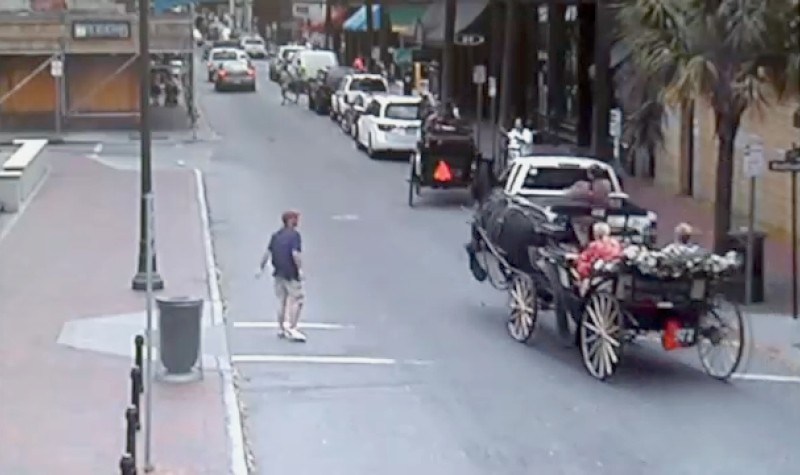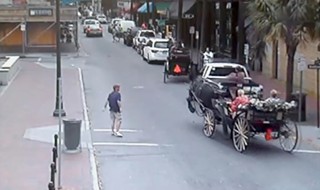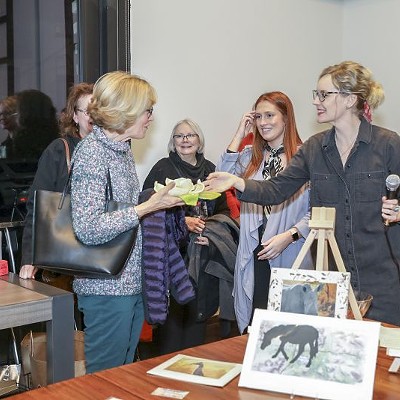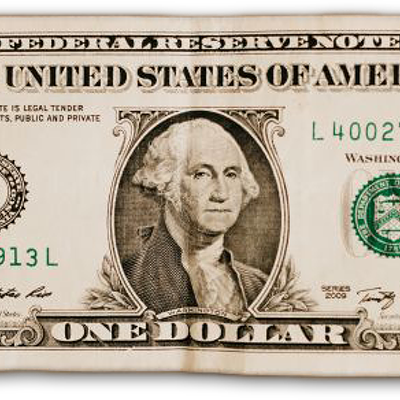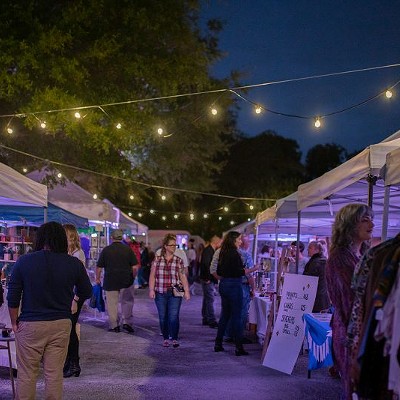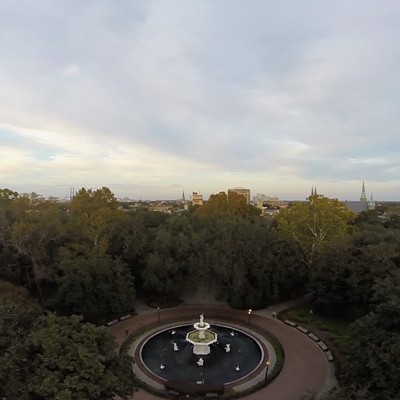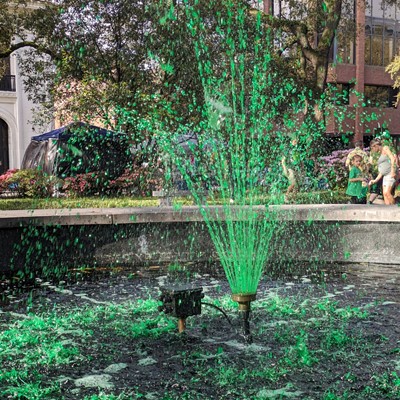SAVANNAH MADE NATIONAL NEWS LAST WEEK, when a carriage owned by Historic Savannah Carriage Tours went out of control downtown. The grainy surveillance video got plenty of play on multiple news programs.
The wild ride began near Ellis Square and covered six city blocks, injuring the driver and several tourists, and causing minor damage to several parked cars. The horse —eventually calmed by pedestrians armed with carrots—wasn’t hurt.
Police say that at some point the bit came out of the horse’s mouth and the animal lost its bridle, hence the driver lost control.
“That change of venue, if you will, is a startling event for a horse. It changes everything,” says Taylor Watts, owner of Savannah’s Plantation Carriage Company.
The timing of the incident couldn’t be worse for the national carriage tour industry.
(UPDATE: A few days after this story went to press a similar incident happened in Charleston, S.C.)
Incoming New York City Mayor Bill De Blasio is flexing his progressive bona fides by pushing to ban Central Park’s treasured horse-drawn carriages and replace them with electric faux-antique cars.
“They’re not humane, they’re not appropriate to the year 2014. It’s over,” De Blasio has said of the famous carriages.
Last week, actor Liam Neeson countered sarcastically at a press conference supporting the carriage industry: “That’s just what New York needs—more cars on the streets.”
A Facebook page called “Carriage Horse Cruelty” draws attention to incidents similar to Savannah’s, in a passionate effort to expand the proposed Central Park ban to all carriage tours around the country.
One commenter wrote about Savannah’s Ellis Square incident: “When are you fucking Southern IDIOTS going to learn a HORSE is not a CAR.”
Carriage operators in Charleston, New Orleans, Savannah, and elsewhere are taking the threat seriously, and furtively look north for a precedent that might signal the end of their livelihood as they know it.
“That’s the feeling across the industry,” worries Watts.
Meanwhile, Las Vegas is bucking the trend, so to speak, starting its own carriage tour industry from scratch in the desert.
Back in Savannah, a much older town whose streets were designed for animals, not cars, Watts simply says:
“Horses built this city.”
THE LARGER THREAT comes as Savannah is considering a new consolidated ordinance that would “level the playing field” between carriages, trolleys, and walking tours, says Bridget Lidy of the newly-created City of Savannah Tourism Management & Ambassadorship Department.
Currently the City has a separate horse carriage ordinance, a “tour-for-hire” ordinance, and a newer quadricycle ordinance to address the Savannah Slow Ride.
“All of them have different rules and regulations for that particular industry,” says Lidy. “We’d like to merge them under one ordinance.”
One thing that Lidy says is unlikely to change is the City of Savannah’s remarkably trusting relationship with the four carriage tour companies here.
Indeed, Savannah’s carriage ordinance is largely unchanged from its inception in 1977, and is mostly a series of guidelines leaving day-to-day operation up to individual companies.
Training of drivers, for example, is left up to the companies and usually involves a 4-8 week period.
“It’s not something that occurs in a week. By the time we get to the point drivers are going out by themselves, they’ve had a substantial amount of training time,” says Watts, who opened his company here in 1999 after years of horse tour experience in Charleston and elsewhere.
“This industry is not a science, it’s an art. You have to be patient and work with the horses, and know which stimuli are more effective to that animal and which aren’t,” says Watts.
He cites the example of something as simple as a piece of paper blowing in the wind as an event which might unnerve a horse and make it difficult to control.
An idiosyncrasy of the current ordinance is the longstanding ban on carriage tours between 4:30-6 p.m. Monday-Friday.
It’s a ban which anyone attempting to drive downtown during afternoon rush hour has probably noticed emphatically does not apply to tourist trolleys and buses.
“That’s from 1977,” laughs Lidy. “The rationale at the time was that was when the first company here in town would take the horses back to the stalls for feeding time.”
Ironically, such a ban would be much more effective on motorized tourist vehicles, since horse carriages are actually required to pull over for auto traffic. Trolleys and buses, however, are specifically prohibited from pulling over, no matter how slow they go.
The last notable confrontation between the City and local carriage tour operators came two years ago, when a new Wet Willie’s location led to the removal of the long-standing tradition of carriage tours embarking from City Market.
Now, the four local companies utilize ten different points between them, ranging from Madison Square to St. Julian Street.
As elsewhere, individual carriage drivers in Savannah are ticketed personally for driving infractions, such as running a red light or failing to turn lights on—but other infractions, such as faulty equipment, are ticketed to the company itself.
On the always-controversial issue of animal rights and hot summer temperatures, there is no city or state law currently governing the conditions under which a Savannah carriage tour must operate.
The local ordinance simply says:
No animal shall be subject to any condition or treatment, whether in service or out of service, which will impair the good health and physical condition of that animal.
“There is an agreement with the carriage operators that as the temperature increases, our level of monitoring increases. We’ve worked with the industry to come up with those standards,” Lidy says.
“When the humidity and temperature reach a certain level, there’s another layer of protection where they might then pull their horses off the streets.”
Lidy says whenever summers get unusually hot, the level of citizen complaints rises with the mercury level.
“A couple of years ago when it was super hot, we got a lot of pushback. That normally happens every year,” she says.
“The operators are the ones who most want to protect the horses, because they don’t want to damage them and have them not be able to operate in the future.”
The City requires that each horse get a minimum of two checkups by a vet per year.
Watts explains, “We put a lot of effort into maintaining and monitoring the horses throughout the year—not just in July when its 97 degrees outside and Aunt Bertha sees a hot horse.”
TO SEE FOR YOURSELF what a tightly-regulated carriage industry looks like, head two hours north to Charleston.
At any given time, only 20 horse or mule-drawn carriages from five companies are allowed out on Charleston streets.
Not a single one more.
Your carriage driver halts at Market Street waiting for the 20th carriage to return to its barn so you can begin. A runner sprints from the barn with the “tag” proving that the 20th carriage has returned.
A lottery wheel right on the corner in front of you pops out a plastic ball which determines which of three designated zones your tour will cover. You don’t get to pick which zone, and neither does your driver.
The reason has little do with out-of-control horses or hot summer temps, but geography and history.
“Something Savannah has going for us that Charleston doesn’t is James Edward Oglethorpe,” says Taylor Watts of our remarkably carriage-and-pedestrian friendly urban design, in contrast to Charleston’s tightly-constrained historic district.
“In Charleston there’s only one way on and off the peninsula. There are two ways south and two ways north. That’s it,” he says. “If their carriage industry tries to tour more than 20 carriages, there just isn’t anywhere for them to go. That’s how the lottery system evolved in Charleston, to spread them out.”
While we have an ordinance dictating that carriages must be spaced out, Savannah’s drivers have more freedom to freelance routes in the case of congestion, construction, or the presence of another carriage.
Any new Savannah tourism ordinance will likely not include any notion of tour zones—though carriages will continue to be prohibited from major thoroughfares such as Bay and Broughton Streets.
As to the actual number of carriages, “At this time we do not have any limitation on the amount of horse and carriages or any other kind of tour number or type of tour to be out on the streets,” Lidy says.
While Savannah generally prides itself on doing things differently from Charleston, there’s one area our carriage tour industry modeled directly on Charleston’s:
Horse poop.
In Charleston, equine waste must be immediately marked by a half of a rubber ball with a flag on it, and sprayed with disinfectant. The driver must immediately call or text for a cleanup crew.
Savannah has installed a virtually identical system, with cleanup provided by a separately contracted company owned by one of the local carriage tour operators, and funded by a regular fee.
“Three weeks ago, for example, we noticed a lot more spills. We notified the companies that, hey, spills are picking up,” says Lidy. “We hand-delivered letters to the companies so they could warn drivers that we’d be stepping up citations if it continues.”
(In Savannah most tour infractions are only $100, compared to multiple hundreds in Charleston; the exception here is motor coach violations at $250.)
BUT PERHAPS THE BIGGEST difference between the Charleston and Savannah carriage industries is their volume.
In Savannah, carriage tours are simply a much smaller part of the overall picture.
“Here your big companies are the trolley companies,” explains Watts. “In Charleston your big companies are the carriage companies. And they are as big as Old Town Trolley here. They move a lot of people there.”
Increasingly in Savannah, however, the conveyance of choice that’s also moving a lot of people is the growing phenomenon of large chartered motor coaches.
“One of the big issues is the sheer number of motor coaches coming into town now, to drop off people at The Lady and Sons for a quick lunch as they’re coming off I-95, or dropping them off at a hotel,” says Lidy.
As infill development for things like new hotels increases throughout downtown, the number of unused large parking lots for motor coaches to spend idle time is decreasing, says Lidy, causing a real crunch.
“My dream world is have an area outside the core historic district as a holding zone where motor coaches, if they’re dropping people off at the Cathedral or something, can go park, idle, whatever,” she says.
“But it should be out of the historic district, allowing less congestion, as opposed to having a huge motor coach circling around the square waiting for the tour to be over.”
Lidy says the City is ramping up its enforcement and collection of the “preservation fee,” a $1 per head charge on each person over the age of 12 taking a carriage or motorized tour, including audits of local tour companies.
“As tourism is increasing and the revenue was staying at the same level, we were sort of scratching our heads,” says Lidy, explaining that the City is shooting for about $620,000 a year to be collected from those fees, to go to preserving monuments, maintaining the Visitors Center, and funding 2.5 enforcement positions, among other needs.
She says the intent of the new Tourism and Management and Ambassadorship Department and associated ordinances is “to sustain the positive economic impacts of the tourism industry, protect historic assets, respect resident’s quality of life, and enhance the visitor experience.”
Its creation came out of feedback from a process led by the Tourism Advisory Committee in 2013, and includes input from the Downtown Neighborhood Association, Historic Savannah Foundation, Visit Savannah, and the Tourism Leadership Council, among others.
“This new department will not only be involved with enforcement related activities —like writing tickets—but also moving to a mode of compliance, where we don’t have to write tickets but companies are proactively cooperating,” Lidy says.
It’s all directed toward a more holistic approach to local tourism—not so much viewing it as a conglomeration of separate industries, but as more of a single entity.
“Our tourism product continues to get more and more complex, with more hotels and many terrific new restaurants coming in,” says Visit Savannah President Joe Marinelli. “We all have to work together to maintain some level of balance between the residential experience, the retailer experience and the visitor experience.”
“There’s a certain visitor that really enjoys the horse and carriage tour. Then another type of visitor very much enjoys the Segway tour. I love that the new offerings available here are helping us appeal to different tastes,” he says.
TWENTY BUCKS. That’s about how much a carriage tour costs per person—roughly the same as a walking tour or a trolley tour.
Except horses must be fed, stabled, groomed, and cared for every day, regardless of weather or how busy the season.
Why do carriage tour operators do it, when it’s much more profitable to round up a bunch of tourists with to-go cups and stroll around telling ghost stories?
“It’s a lifestyle choice. If I was looking to do something for money, I’d be doing something totally different,” says Watts.
“I was fortunate enough to keep all the kids in the barn with me until they went off to school. Who else gets to do that?”

